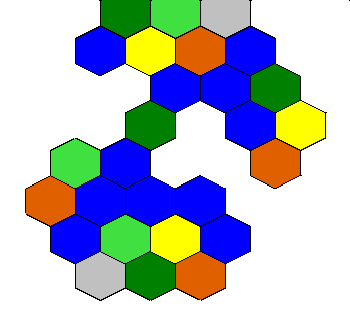zum Spiel
| für Spieler | Homepage-Start
|
Die Siedler von Catan
Intimate Settlers
|
aktualisiert am 11.12.1997
Designed by Duncan Adams and Nic Chilton ©
1997

|
--
|
This variant is currently going under a playtest.
I am happy for anyone to use the rules, but please email
me so that I know who is using it, and to keep you informed of changes
and when the final version is ready. |
--
|
Intimate Settlers is a game for two players that uses
the Settlers of Catan basic game. The two players are small nations surrounded
by uncharted territory. The aim is to expand your territory, building trade
routes, hopefully to the mythical homeland of a people across the unknown.
Playing time, approximately 90 minutes.
1. Game Components
To play this variant only a basic set of Settlers (either
Kosmos or Mayfair) is needed. Each player takes one colour (for roads,
settlements and cities), and then the roads of one of the two remaining
colours (to be used as ships). Optionally counters may be used for keeping
track of additional Victory Points.
2. Set-up
The resource (raw material) cards and development cards are
shuffled and placed in piles as in the standard game. Each player is given
the following seven hex tiles, the rest are put to one side for use in
the 'Discovery' stack.
-
5 Land Hexes, one tile of each type: Forest, Pasture, Farm
Land, Hills, and Mountains
-
2 Sea Hexes - a plain Sea Tile and a 3:1 Harbour.
The Five land tiles are placed together in two rows (the
green tiles in the diagram), with the two tile row squarely facing the
other player. The player can decide where to put each land tile. This set
of five tiles is known as the players Home Base. The plain sea tile
and the 3:1 harbour are then placed adjacent to the land tiles (shown as
blue in the diagram).

Once each player has done this, the space between the
two Home Bases should be measured to ensure they are four tiles apart.
This can be achieved by temporarily placing four tiles and moving each
players starting set up so that they are exactly four tiles apart - these
temporarily placed tiles can then be removed.
Each player is given the number tiles 4, 5, 8, 9, 10
to be placed on the land tiles. The player going first, determined by highest
dice role, places his/her first number tile, player B then places, his/her
first number tile, this is repeated for each tile until each player has
placed all five number tiles.
Each player then places two settlements, shown by 'A'
in the diagram at the intersection between three land hexes. A road is
placed next to each settlement on any of the surrounding edges (as in the
standard game). Player A places the first road, then player B places their
first, player A places their second, etc.
The remaining Hex and number tiles will be used when exploring
the undiscovered region. Shuffle all the remaining Hex Tiles (land, sea,
and harbours), and place them in a bag to allow them to be drawn randomly,
called the 'discovery' stack. Accordingly the remaining unused number tiles
should be mixed in another bag to allow random drawing when a land tile
has been discovered.
To complete the set-up each player then choose any three
resource cards.
3. Playing the Game
The game is then played like the standard Settlers game,
with each player taking turns. The game also uses rules from the seafarer
expansion set for ships (though the additional Victory Points are different)
- these have been summarised below for those unfamiliar with the expansion
set.
An important difference between this variant and the basic
game is in trading. The players in this game may no longer trade
with each other, although trading with the bank at 4:1 or through settlements
on harbours is still allowed.
The victory conditions the game is to reach 18 victory
points. These are awarded as in the basic game, but additional victory
points are also available (see section below)
4. Ships
Intimate settlers has ship units, as used in the seafarer
expansion set. Building ships cost one wool and one wood. Ships are like
roads, placed along the edges of tiles, either on coastal edges or in open
sea. Newly built ships must be placed either next to an own settlement
or city and/or next to an own ship (branching is allowed). It is however
not allowed to be built continuing on from a road (and vice versa for building
roads onto ships), unless a settlement or city has been built at the connecting
intersection.
In general ships are used on sea/coasts like roads are
on land. If a chain of ships, or a ship line, built into the sea reaches
land a settlement may be built (but the distance rule still applies). An
uninterrupted ship line between two settlements is called a 'closed ship
line', and a ship line which does not (yet) connect is called an 'open
ship line'. The foremost ship of an 'open ship line' may be displaced and
moved elsewhere (according to the rules governing ship placement). Only
one ship per turn may be displaced, and this cannot be a ship built in
the same turn. Ships in a 'closed ship line' may not be displaced.
The cards that apply to roads in the basic game also now
apply to ships. The longest trade route card includes roads and ships,
and the "Road Building" card allows building of two ships, two roads, or
one of each. There is no pirate ship (as in the seafarer expansion) in
this variant.

5. Discovery
All of the area outside the 14 tiles used in the initial
set-up is treated as 'undiscovered region' of the board. Once a player
places a ship or road along the edge towards an intersection where a hex
tile is missing he/she then draws a hex tile randomly from the bag of hex
tiles (the 'discovery' stack) and places it on the board to fill in the
missing space. If the tile is a harbour the player may choose the orientation
of the tile, although if it is being placed next to another harbour tile
it may not be placed so that it causes an intersection to contain two ports.
If it is impossible to place the harbour tile without causing two ports
at one intersection, then another tile may be drawn and the harbour shuffled
back into the bag.
If the tile drawn is a land tile, then the player randomly
draws a number tile to place on the land tile. This land produces one resource
card of the same type for the player who drew the tile. If the hex
tile drawn is a sea or harbour tile, then no resource card is produced.
5.1 Building into the unknown.
If a player is building two or more roads/ships on the same
trade route where the first ship built to the intersection with a missing
tile, the player may build one unit at a time deciding if he/she wants
to carry on building (given sufficient resources in their hand) once the
hex has been drawn. This allows a player to decide if they want to stop
if they discover land or sea.
6. Special Victory Points
In addition to the Victory Points awarded as in the basic
game of settlers the following VP's are available.
6.1 Settlement on New Land
The first player to build a settlement on each new island
is awarded 1 extra Victory Point. A new Island is one consisting of one
or more land hexes that have been 'discovered' and are not connected by
land to either players home base (i.e. surrounded by sea hexes and/or undiscovered
regions) at the time of building. Note: if a 'new land' subsequently turns
out to be connected to a players Home Base, or other previously discovered
Island by discovering land in a surrounding 'undiscovered' region, the
Victory Point still stands, since it was awarded for the status of the
island 'at the time of building'. The first settlement on each 'discovered'
island is awarded the extra VP, and not the first settlement by each player
(if one player has built on an island, the other player does not get an
extra VP for building on the same island).
6.2 Foreign Trade Route
An aim of the game is for a trade route to be established
with the opposing player's home base. Extra Victory Points are available
for building onto the opposing players Home Base (i.e. original starting
five land hexes. If the starting island have been extended by discovered
hexes, these do not count in terms of awarding these VP's, since they are
not part of the original Home Base.
-
Building the first ship along the edge of one of a land hex
of the opponents gains 1 Victory Point.
-
Building the first settlement on the opponents Home Base
gains 5 Victory Points.
-
Upgrading the first settlement on the opponents Home Base
to a city is 7 Victory Points
Note: These are mutually exclusive. If a player
is claiming the 5 VP, he/she cannot claim the 1 VP for the ship along the
edge of the Home Base. Similarly if the settlement is upgraded they get
7 VP for the city and do not claim 5 VP for the settlement or 1 VP for
the ship along the edge.
If a player has claimed +1 VP for building a ship along
the edge of a land tile of the opponents Home Base, and subsequently displaces
this ship - the VP is lost.
7. Optional Rules
The Following extra rules are currently optional extra's.
We are hoping that feedback from the play tests will decide their fate.
Please email me with comments.
a) Play with the Pirate Ship as per Seafarer rules.
The pirate ship starts on any sea hex, in the middle
of that hex.
i) If a player throws a 7, he can choose whether to move
the thief or the pirate ship. If he moves the pirate ship he can steal
a card from an owner of neighbouring ships.
ii) If a player plays a knight card, he again has the
same choice.
iii) A ship can neither be placed at nor removed from
an edge adjacent to the pirate ship.
b) All Ships, roads, Settlements and cities on opposing home
base to count cumulatively towards 18VP's required to win the game
c) At the beginning of the game, four of each product are
shuffled together to make a "trade pack". On a players turn he/she may
exchange any one only of their resource card for the top unknown card from
the "trade pack". Once the trade pack is exhausted it is re-shuffled and
may be used again.
zum Seitenanfang |
zum
Spiel | für Spieler | Homepage-Start








